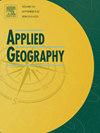Revealing disparities and driving factors in leisure activity segregation of residents and tourists: A data-driven analysis of smart phone data
IF 4
2区 地球科学
Q1 GEOGRAPHY
引用次数: 0
Abstract
Activity-based segregation can lead to inequalities and exclusivity, hindering the inclusive construction of sustainable cities. However, few studies have delved into leisure segregation among residents and tourists across their full leisure activities. To address this gap, this paper examines Zhoushan, an island tourist city in China, aiming to quantify the leisure segregation of residents and tourists in the whole city, and to analyze the driving environmental factors. First, we identify the leisure destinations for both residents and tourists on different dates, using smart phone data and POI data. Then, we measure the leisure activity segregation across different group and dates. Finally, we employ XGBoost and SHAP models to explore the associations between different leisure segregations and urban built environments. The results show: (1) significant differences in leisure type preferences between residents and tourists, especially on weekends; (2) a higher degree of leisure segregation among tourists compared to residents, particularly in the new city and Puzhu functional area; (3) higher floor area ratios, greater POI density, and closer proximity to inter-city bus stations are driving factors in mitigating leisure segregation for tourists. These findings provide strategic recommendations for planners and decision-makers to promote interaction among diverse groups in urban leisure spaces.
求助全文
约1分钟内获得全文
求助全文
来源期刊

Applied Geography
GEOGRAPHY-
CiteScore
8.00
自引率
2.00%
发文量
134
期刊介绍:
Applied Geography is a journal devoted to the publication of research which utilizes geographic approaches (human, physical, nature-society and GIScience) to resolve human problems that have a spatial dimension. These problems may be related to the assessment, management and allocation of the world physical and/or human resources. The underlying rationale of the journal is that only through a clear understanding of the relevant societal, physical, and coupled natural-humans systems can we resolve such problems. Papers are invited on any theme involving the application of geographical theory and methodology in the resolution of human problems.
 求助内容:
求助内容: 应助结果提醒方式:
应助结果提醒方式:


